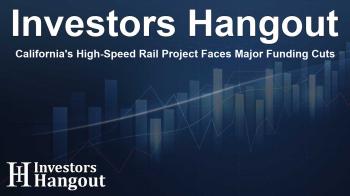California's High-Speed Rail Project Faces Major Funding Cuts

California's High-Speed Rail Project Faces Major Funding Cuts
The ambitious high-speed rail project in California is facing significant obstacles as it navigates through hurdles, particularly in funding. The recent withdrawal of $175 million from the project by the Trump administration adds to the existing challenges, marking yet another setback for an initiative that has long been plagued by delays and budget overruns.
Details of the Funding Withdrawal
U.S. Transportation Secretary Sean P. Duffy has made it clear that the funding earmarked for critical aspects of the project, such as grade separation, design work, and the construction of a station in Madera, has been officially withdrawn. This decision reflects a stance against what is deemed a 'failed experiment' in high-speed rail development.
Statements from Officials
Duffy stated, "The waste ends here. As of today, the American people are done investing in California's failed experiment.” His focus is now shifting toward efficient transit systems that demonstrate effective management and execution, ensuring taxpayer dollars are utilized effectively.
Investment and Cost Implications
The ongoing funding cuts pose a substantial risk to the 16-year endeavor that aims to connect Los Angeles and San Francisco with an efficient, three-hour train journey. The project was initially projected to cost around $33 billion, but financial estimates have skyrocketed to a staggering $128 billion as construction continues amidst confusion and mismanagement.
Construction Progress
Despite the mounting challenges, the project has achieved some milestones, including the completion of 70 miles of guideway and more than 50 major railway structures. However, these accomplishments are overshadowed by the delays, as no segment of the rail system is operational, and completion seems to be years down the line, highlighting severe operational inefficiencies.
Political Tensions Surrounding the Project
The conflict over funding illustrates the ongoing tension between the Trump administration and California's leadership, particularly Governor Gavin Newsom. This is not the first instance of funding withdrawal; in an earlier move, $4 billion was cut, leading to legal challenges as California pursued a lawsuit against the federal government for what it calls unlawful actions.
Governor Newsom's Response
Governor Newsom has been vocal in his opposition to the funding cuts, underscoring his commitment to sustainable transportation initiatives despite the federal government's stance. His administration continues to explore avenues to support progressive transportation methods, including electric vehicle incentives, even amidst changing federal policies that would otherwise hinder such programs.
Future of California's High-Speed Rail
Looking ahead, the future of California's high-speed rail project remains uncertain. As officials and advocates push for continued investment in innovative transportation methods, they face the dual challenge of overcoming political adversity and ensuring fiscal responsibility. The stakes are high, both for the state's infrastructure and broader economic growth as ambitious transportation projects often catalyze regional development.
The Vision Ahead
Ultimately, supporters of the project remain hopeful that, in time, a viable solution can emerge that reconciles the need for efficient transportation with accountability and practicality, allowing California to realize its vision of a world-class high-speed rail system. The road ahead may be long and fraught with obstacles, yet determination can often pave new pathways to success.
Frequently Asked Questions
What recent funding withdrawal has affected the California high-speed rail project?
The Trump administration recently withdrew $175 million from the funding allocated for the California high-speed rail project, further complicating its progress.
What was the initial budget for the California high-speed rail project?
The original projected cost for the project was around $33 billion, but recent estimates have ballooned to approximately $128 billion.
Who is the U.S. Transportation Secretary that announced the funding cut?
U.S. Transportation Secretary Sean P. Duffy announced the funding cut, labeling the California high-speed rail project a 'failed experiment'.
What are the key challenges faced by the California high-speed rail project?
Key challenges include funding withdrawals, rising costs, extensive delays, and political conflicts that threaten the initiative's viability.
How has Governor Gavin Newsom responded to the funding cuts?
Governor Newsom has criticized the funding cuts and remains committed to sustainable transportation, exploring options for electric vehicle incentives despite federal changes.
About The Author
Contact Logan Wright privately here. Or send an email with ATTN: Logan Wright as the subject to contact@investorshangout.com.
About Investors Hangout
Investors Hangout is a leading online stock forum for financial discussion and learning, offering a wide range of free tools and resources. It draws in traders of all levels, who exchange market knowledge, investigate trading tactics, and keep an eye on industry developments in real time. Featuring financial articles, stock message boards, quotes, charts, company profiles, and live news updates. Through cooperative learning and a wealth of informational resources, it helps users from novices creating their first portfolios to experts honing their techniques. Join Investors Hangout today: https://investorshangout.com/
The content of this article is based on factual, publicly available information and does not represent legal, financial, or investment advice. Investors Hangout does not offer financial advice, and the author is not a licensed financial advisor. Consult a qualified advisor before making any financial or investment decisions based on this article. This article should not be considered advice to purchase, sell, or hold any securities or other investments. If any of the material provided here is inaccurate, please contact us for corrections.

